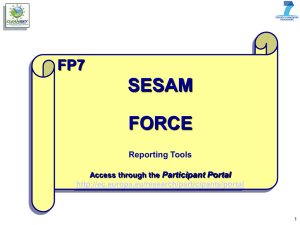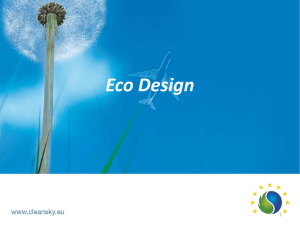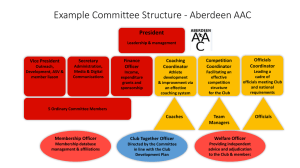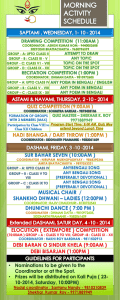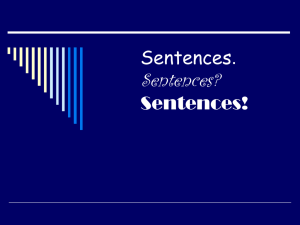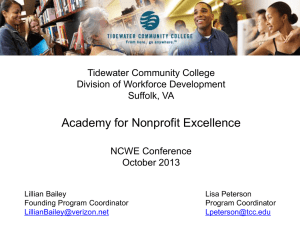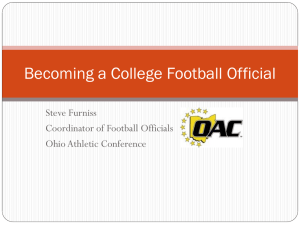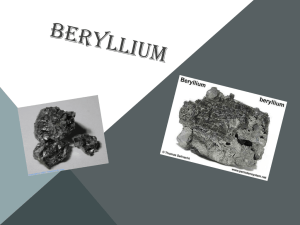Add your title
advertisement
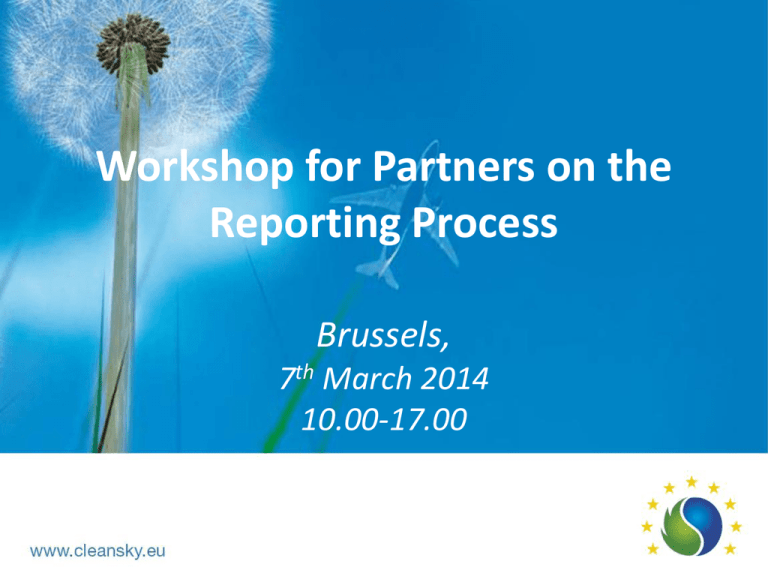
Workshop for Partners on the Reporting Process Brussels, 7th March 2014 10.00-17.00 Agenda 10:00 - 10:15 Registration and welcome coffee 10:15 - 10:30 Introduction on the reporting process workshop st 10:30 - 13:00 1 Part: Technical reporting + SESAM 13:00 - 13.30 Questions and answers session 13:30 - 14:30 Lunch and coffee break nd 14:30 - 16:15 2 Part: Financial Reporting + FORCE 16:15 - 16:30 Coffee break 16:30 - 17:00 Questions and answers session st 1 Part: Technical reporting + SESAM st 1 Part: Technical reporting + SESAM Content Reporting process Deliverables Periodic Report Dissemination Final Report EU Financial Contribution Distribution Common problems encountered in the reporting process Project steps A project has: n periods x deliverables 60 days from every deadline to complete the reporting specific reporting documents to be submitted every period Period 2 Period 1 Period n Periodic Report 1 Form C UoR Periodic Report 2 Form C UoR 60 days 60 days End Start Deliv 1 Deliv 2 Deliv 3 Periodic Report n Final Report Form C UoR CFS 60 days Deliv x Period Report (technical) The technical reporting The following documents have to be delivered (within 60 days) after each period: The following documents have to be delivered (within 60 days) at the end of the project: Periodic Report (for the period in question) Periodic Report (for the final period) Deliverables (to be uploaded at their due date, Final Report as stated in NEF) Deliverables (all foreseen deliverables have to Usage of Resources* be uploaded before submitting the last Periodic Report) Usage of Resources* *Usage of Resources has moved from the Periodic Report to Form C, therefore, Financial and Technical reporting should be done together. Consortium General workflow Participant Portal Log on on the Participant Portal (with the Ecas account – appropriate Role already defined) Go to the tab ‘MY PROJECTS’ For the concerned Project, click on (Reports and Deliverables) Clean Sky JU SESAM Coordinator fills in the Reports and uploads the Deliverables Coordinator submits the Reports and the Deliverables to Cleansky The Project Officer checks the Reports and the Deliverables (possibility to request a Revision) Access the Participant Portal Electronic submission of Reports and Deliverables. Access: http://ec.europa.eu/research/participants/portal (1) (2) (3) RD : Hyperlink to Reporting and Deliverables Phase « Active » means that the Grant Agreement has been signed Reports & Deliverables Deliverables Deliverables Deliverables - workflow Consortium Clean Sky JU 2 STEPS 1) 2) The Topic Manager validates the Deliverables The Coordinator uploads and submits them to Clean Sky JU A new version has to be uploaded PO Views Deliverable(s) Validation / Rejection PO Approval: Accept Ask for revision Deliverables - defining Deliverables are defined in NEF during the Negotiation process. Modifying deliverables, throughout the life of the project, can be done via Amendments (when the NEF session is re-opened). NEF Deliverables - defining The Deliverables List is imported automatically in SESAM. NEF SESAM The Coordinator uploads the Deliverables. Deliverables - uploading The Coordinator uploads the Deliverables. SESAM Text Deliverables are uploaded as PDF documents. Deliverables of other nature than reports (equipment, software, etc) should be uploaded as a document containing a product description, pictures, etc. Deliverables - submission Coordinator submits the Deliverable to Cleansky Benef. Benef. Note: temporary status Deliverables - acceptance Once submitted, the deliverable goes in the “Submitted deliverable” state. Benef. (1) If the Deliverable is accepted by the Project Officer, the status changes to “Accepted” (2) Benef. If the Deliverable is rejected by the Project Officer, the status changes to “Rejected” and a new version has to be uploaded. (3) Reports Reports Publications, Patents, Dissemination Activities and Exploitable Foregrounds Reports - workflow Consortium 2 STEPS 1) 2) After previous validation from the Topic Manager, the Coordinator creates, saves, modifies and completes the Reports Clean Sky JU - Display Report - Download Attachment The Coordinator submits the Reports to Clean Sky JU - PO assessement taking into account the Topic Manager’s feedback Report(s) have to be revised and resubmitted - If needed : PO asks for a revision Reports - Periodic Report Periodic Report Periodic Report - selection (1) (2) (3) Periodic Report - content Content: Project Periodic Report – general information Declaration by the scientific representative of the project coordinator 1. Publishable summary 2. Core of the report 3. Deliverables and milestones tables To be submitted within 60 days after the end of each Reporting Period (including the last Reporting Period) Periodic Report - content Content: Project Periodic Report – general information Declaration by the scientific representative of the project coordinator 1. Publishable summary 2. Core of the report 3. Deliverables and milestones tables Periodic Report – general information Periodic Report - content Content: Project Periodic Report – general information Declaration by the scientific representative of the project coordinator 1. Publishable summary 2. Core of the report 3. Deliverables and milestones tables Periodic Report – declaration Periodic Report - content Content: Project Periodic Report – general information Declaration by the scientific representative of the project coordinator 1. Publishable summary: Summary description of project context and objectives Description of work performed and main results Expected final results and potential impacts Project public website address 2. Core of the report 3. Deliverables and milestones tables Periodic Report – publishable summary Publishable summary and the attachment are published on CORDIS!!! Periodic Report - content Content: Project Periodic Report – general information Declaration by the scientific representative of the project coordinator 1. Publishable summary 2. Core of the report: Project objectives for the period Work progress and achievements during the period Project management during the period 3. Deliverables and milestones tables Periodic Report – core of the report Mandatory !!! Periodic Report - content Content: Project Periodic Report – general information Declaration by the scientific representative of the project coordinator 1. Publishable summary 2. Core of the report 3. Deliverables and milestones tables Periodic Report – deliverables and milestones Periodic Report – saving A Periodic Report not submitted goes in an intermediate state – Draft. Click on the hyperlink to modify, submit … Periodic Report – submission An automatic email is sent to the Project Officer in Cleansky. Reports – Dissemination and Exploitation Publications Patents Dissemination Activities Exploitable Foregrounds The Publications, Patents, Dissemination Activities and Exploitable Foregrounds List are part of the Final Report Reports – Publications Reports – Patents Reports – Dissemination Activities Reports – Exploitable Foregrounds Reports - Final Report Final Report Final Report - selection (1) (2) Final Report - content Content: Project Final Report – general information 4.1. Final publishable summary report 4.2. Use and dissemination of foreground 4.3. Report on societal implications To be submitted within 60 days after the end of the project Final Report - content Content: Project Final Report – general information 4.1. Final publishable summary report 4.2. Use and dissemination of foreground 4.3. Report on societal implications Final Report – general information Final Report - content Content: Project Final Report – general information 4.1. Final publishable summary report: Executive Summary Summary description of project context and objectives Description of main S & T results/foregrounds Potential impact and main dissemination activities and exploitation results Address of project public website and relevant contact details 4.2. Use and dissemination of foreground 4.3. Report on societal implications Final Report – publishable summary Publishable summary and the attachment are published on CORDIS!!! Final Report - content Content: Project Final Report – general information 4.1. Final publishable summary report 4.2. Use and dissemination of foreground: Publication List List of applications for Patents, Trademarks, Registered designs, etc List of Dissemination Activities Exploitable Foregrounds List 4.3. Report on societal implications Final Report – use and dissemination of foreground Final Report - content Content: Project Final Report – general information 4.1. Final publishable summary report 4.2. Use and dissemination of foreground 4.3. Report on societal implications Final Report – societal implications Final Report – submission Reports - Final Report EU Financial Contribution Distribution Final Report EU Financial Contribution Distribution Final Report EU Financial Contribution Distribution (1) (2) It has to be issued within 30 days after receipt of the final payment of the EU financial contribution Final Report EU Financial Contribution Distribution Common problems encountered when reporting Content: Periodic Report and Final Report are different – the two reports contain different information thus the need for a Periodic Report for the last period. Publishable Summary is public – its content is published on Cordis, thus the need to making sure that it doesn’t contain confidential information. The possible need of having an amendment – for certain issues preventing the reporting you may opt for an amendment. Final Report is complementary to Periodic Reports The Final and Periodic Reports have different contents. The Periodic Report for the last period still needs to be submitted. Periodic Report Final Report Declaration by the scientific representative of the project coordinator 4.1. Final publishable summary report 1. Publishable summary Summary description of project context and objectives Description of work performed and main results Expected final results and potential impacts Project public website address 2. Core of the report 3. Deliverables and milestones tables Executive Summary Summary description of project context and objectives Description of main S & T results/foregrounds Potential impact and main dissemination activities and exploitation results Address of project public website and relevant contact details 4.2. Use and dissemination of foreground 4.3. Report on societal implications Reports – publishable summary (1) (3 a) (2) (3) (3 b) http://cordis.europa.eu/home_en.html Reports – publishable summary Project: NEELEFFECTINTHESKY But it’s even easier… Reports – publishable summary CORDIS SESAM Access to the attachment Reports – publishable summary CORDIS SESAM (1) (2) Amendments For issues blocking the reporting process, you may apply for an amendment: The project accumulates delays and there is a need for an extension of duration. The Coordinator person is changed. The Reporting Periods are changed. The Annex I is changed. For more information consult the CSJU GAPs amendments guide, available here: http://www.cleansky.eu/sites/default/files/documents/csjufp7_gaps_amendments_guide__external_version-1.pdf However… It is subject to Topic Manager and Project Officer approval. An amendment incurs bureaucracy and is time consuming. It has to be requested at the latest two months prior the end date. Clean Sky JU – operational team Project Officers in Clean Sky JU: ECO – Paolo TRINCHIERI - Paolo.Trinchieri@cleansky.eu GRA – Andrzej PODSADOWSKI - Andrzej.Podsadowski@cleansky.eu GRC – Sebastien DUBOIS - Sebastien.Dubois@cleansky.eu SAGE – Vittorio SELMIN - Vittorio.Selmin@cleansky.eu SFWA – Helmut SCHWARZE - Helmut.Schwarze@cleansky.eu SGO – Ruud DEN BOER - Ruud.DenBoer@cleansky.eu Support Project Officers: Sebastiano ZILLI - Sebastiano.Zilli@cleansky.eu Costin-Ciprian MIGLAN – Miglan.Costin-Ciprian@cleansky.eu FP7 Helpdesk For problems related to the Participant Portal: access rights, availability of buttons, etc. For questions about the submission process. Helpdesk : For Consortium Digit eFP7 team e-mail: ec-research-it-helpdesk@ec.europa.eu Phone: +352 43 01 31 570 Agenda 10:00 - 10:15 Registration and welcome coffee 10:15 - 10:30 Introduction on the reporting process workshop st 10:30 - 13:00 1 Part: Technical reporting + SESAM 13:00 - 13.30 Questions and answers session 13:30 - 14:30 Lunch and coffee break nd 14:30 - 16:15 2 Part: Financial Reporting + FORCE 16:15 - 16:30 Coffee break 16:30 - 17:00 Questions and answers session Questions and answers session Lunch and coffee break 2nd Part: Financial Reporting + FORCE 2nd Part: Financial Reporting + FORCE Content Reporting periods Documents to be submitted Explanation of the Use of the Resources Payment types Identification of direct/indirect costs/ Special case of SME owners Certificate of financial statements (CFS) -Common mistakes Good / bad practices encountered during the validation of cost claims Reporting periods Documents to be submitted in original (= signed paper version) Original* signed Form C All costs should be uploaded in Force. After electronic submission, the original signed document must follow by post immediately (except as below) Original* CFS when needed Compulsory when the reimbursement of costs is equal or superior to EUR 200,000 when cumulated with all previous payments for which a certificate on the financial statements has not been submitted and in any case at the end of the Project. * except if the Grant has been amended for the “Electronic submission only” or if it has been signed after the 01/01/2013. Explanation on the use of resources (Electronic) A short description of the tasks carried out with the breakdown is compulsory. Those explanations have to be reported into Force while preparing the form C. The WP references should be reported as well. How to revise a Form C on Force Please click on the organization name to edit the Form C that must be revised (no need to add an adjustment Form C) Explanation of the Use of the Resources Please provide an explanation of personnel costs, subcontracting and any major costs incurred by each beneficiary, such as the purchase of important equipment, travel costs, large consumable items, etc., linking them to work packages. There is no standard definition of "major cost items". Beneficiaries may specify these, according to the relative importance of the item compared to the total budget of the beneficiary, or as regards the individual value of the item. These can be listed in the following table (one table by participant): Explanation of the Use of the Resources TABLE 3.1 PERSONNEL, SUBCONTRACTING AND OTHER MAJOR COST ITEMS FOR BENEFICIARY 1 FOR THE PERIOD Work Package Amount in € Explanations with 2 decimals Ex: 2,5, 8, Personnel direct 235000.00 € Salaries of 2 postdoctoral students and one lab 11, 17 costs technician for 18 months each 5 Subcontracting 11000.02 € Maintenance of the web site and printing of brochure 8, 17 Major cost item 'X' 75000.23 € NMR spectrometer 11 Major cost item 'Y' 27000.50€ Expensive chemicals xyz for experiment abc Item description Remaining direct 15000.10€ costs Indirect costs TOTAL COSTS 363000.85€ Entering the explanations on the use of resources You must fill in at least one major “Cost” item The “Total” cost is automatically calculated on the basis of the individual cost items. Entering the explanations on the use of resources Actual indirect costs are directly editable (without details). Payment types pre-financing in accordance with Article 6 (of GA) interim payments of the JU financial contribution corresponding to the amount accepted for each reporting period final payment of the JU financial contribution corresponding to the amount accepted for the last reporting period plus any adjustment needed The total amount of the pre-financing and interim payments for each project shall not exceed 80% of the Article 5 (of GA) maximum JU financial contribution set out in Identification of direct costs Direct costs are the eligible costs which can be attributed directly to the project and are identified by the beneficiary as such, in accordance with its accounting principles and its usual internal rules. With regard to personnel costs only the costs of the actual hours worked by the persons directly carrying out work under the project may be charged : either the costs of the actual hours OR the average personnel costs, if this is its usual cost accounting practice and under certain conditions. For SME owners and other natural persons who do not receive a salary: they must charge as personnel costs a flat rate based on the allowances used in the People Specific Programme ( see Annex II of the Grant Agreement for Partners, art. II.14. Eligible costs of the project ) Special case of SME owners SME owners and other natural persons who do not receive a salary shall charge as personnel costs a flat rate. Useful calculator: « SME owners and natural persons without a salary: hourly rate calculation tool » Available at : http://ec.europa.eu/research/participants/portal/desktop/en/funding/r eference_docs.html#fp7 (under << Financial issues>> SME owners and natural persons without a salary: hourly rate calculation tool ) Identification of indirect costs Indirect costs are all those eligible costs which cannot be identified by the beneficiary as being directly attributed to the project, but which can be identified and justified by its accounting system, as being incurred in direct relationship with the eligible direct costs attributed to the project. Identification of the indirect costs, according to the validated methodology : The actual indirect costs method – The beneficiary must have an analytical accounting system OR Simplified method OR The 20 % flat rate option of its total direct eligible costs, excluding its direct eligible costs for subcontracting and the costs of resources made available by third parties which are not used on the premises of the beneficiary. Certificate of financial statements (CFS) (Annex VI – Form D of the Gaps) The Certificate of Financial Statements has to be transmitted to the JU together with the Financial Statements (Forms C). The Certificate of the Financial Statements is composed of 2 separate documents: 1) The terms of reference (TORs) duly signed by the beneficiary and the auditor, representing in fact the engagement letter between the beneficiary and the auditor. The engagement letter must be dated and signed by both parties. 2) The independent Report of Factual Findings to be issued on the auditor's letterhead and dated, stamped and signed by the auditor . The report comprises of the general part (comparable with executive summary) and of a detailed description in table format describing the procedures performed by the auditor and the findings resulting there from. This table should be paraphed by the auditor. A copy of all Form Cs , as submitted to the JU, should be attached to the CFS and should be stamped by the auditor !!! Certificate of financial statements (CFS) Note to beneficiaries and CFS auditors • The Procedures stated in the table of the CFS Report of factual findings (left hand column) should not be altered. The wording should be maintained literally. However the auditors may add further procedures, which they consider necessary • The same applies in principle for the Standard factual findings and basis for exception reporting (right hand column of the table). However, out of the options provided in the model text the relevant ones have to be chosen and the text has to be used only where it is applicable. The model text of the findings and exceptions must NOT be simply COPIED/PASTED !!! In Procedures and Findings/Exceptions, additional information is always welcome... Common Mistakes on Certificates of Financial Statements Term of Reference: not signed by both parties (beneficiary and auditor) In addition, when the procedures performed by the auditors are not correctly reported and in particular: Procedure 1 related to the “personnel cost” : the auditor reports the hours worked for the project while he has to report the average number of hours per year (regardless of the project) Procedures 5 & 6 : subcontract. The auditor declared having performed the check while no sub-contract was reported. Procedure 10 : check on indirect costs must be performed if the “real method” has been used. The common mistake is the missing information about the type of ratio used for the calculation of such costs. Procedure 10 & 11 : indirect costs – when making use of a “simplified method” (procedure 11) the auditor should also confirm that the non eligible costs of procedure 10 have been excluded. Procedure 12 : exchange rate. One of the two options has to be reported (not both). Common Mistakes on Certificates of Financial Statements CFS ! Make sure to use the latest version of Annex VI – Form D available on the CSJU website: http://www.cleansky.eu/content/homepage/referencedocuments Good / bad practices encountered during the validation of cost claims Report of Factual Findings Good practice: In the section « Objective », amongst other information, the total declared costs to be certified are mentioned by the auditors together with the indication of the period(s) covered (current period and previous, if applicable,and any adjustmemts of previous period). NB! Any statement from the auditors should always be based on full cost. Cost claims audited are attached to the report and stamped/paraphed by the auditors. Good / bad practices encountered during the validation of cost claims Sub-contracting Bad practices: 1) procedures confirm the compliance with eligibility criteria for subcontracting, although no such expenses have been charged to the audited project costs as per cost claim. 2) Inconsistent information provided in the procedures compared to exceptions noted on best value for money and factual findings in the report. 3) Unclear information provided in the report on work performed. Good / bad practices encountered during the validation of cost claims Sub-contracting Good practice: Procedure 6 – Tendering Procedure The objective of this procedure is to verify that the principles of best value for money, transparency and equal treatment is respected. It often happens that the beneficiary is unable to provide evidence of fair tendering. However, based on his findings the auditor should at least be able to confirm the principle of best value for money. Exception: When tasks performed by the subcontractor are highly specialised in nature and there are relatively limited sources available for such services. However, prior approval of the project officer is requested and evidence should be provided if needed. Good / bad practices encountered during the validation of cost claims Sub-contracting Good practice: Procedure 6 – Framework contract Subcontracts concluded between a beneficiary and a subcontractor on the basis of framework contracts entered into force before the beginning of the project in accordance with the beneficiary’s usual management may be accepted. Problems encountered during the validation of cost claims – personnel costs Standard productive hours Problem area: The standard productive hours and/ or actual productive hours are sometimes comparatively low. No information is provided in those cases, why and whether the calculation of the individual actual cost rates is still reasonable. No evidence is provided in the certificate to the JU, that the auditor questioned the proper calculation of the number of the productive hours used for determining the actual personal rates. Part-time work should be mentioned by the auditor. Problems encountered during the validation of cost claims - Personal costs Mixing up procedures for actual personnel costs and average personnel costs Problem area: Different procedures have to be applied depending on the method used for determining the personnel costs of the project. The auditor should be very careful in the terms used…. The usage of terms such as “average productive hours” for allocating actual personnel costs to the project is often mixed up with the term “average personnel costs”. They are not equal!! The procedures to be applied are DIFFERENT…. Bad practice: Application of elements of both procedures… the auditor should only use the procedures applicable for the method used!! No mixing!! It doesn’t make sense… Actual personal cost -procedures to be performed by the auditor Procedure n° 1 in full NB. The average number of productive hours for the employees selected is equal to “Productive hours” which represent the (average) number of hours made available by the employee in a year (regardless of the work performed for the project) after the deduction of holiday, sick leave and other entitlements Average personal cost -procedures to be performed by the auditor The auditor should perform the procedure 1 and 4 (A, B or C) : • Procedure n°1 should be performed in full if 4B is applicable: The auditor should base his work on the results of procedure 1 concerning calculation of standard productive hours. • Procedure n°4 B (the common one) The auditor is requested to review the beneficiary's average personnel costing methodology in the light of the 4 criteria set forth in the Commission decision C(2011)714 on the simplification introducing the new acceptability criteria for average personnel costs and based upon the information related to procedure n°1 Procedure n° 4A is for those having a Certificate of Methodology ex-ante validated by the EC. In that case for the procedure n° 1, the auditor is requested to check only the part related to productive hours. Procedure n°4 C is applicable only for SME owners and natural persons not receiving a salary Problems encountered during the validation of cost claims- indirect costs Indirect costs Good practice: Depending on the Indirect Cost Model (ICM) used by the beneficiary, the auditor should complete the following procedures: • Actual Indirect Costs: procedure n°10 • Simplified method: procedure n°10 (part) and 11 • Flat rate: Part of the 10 Bad practice: In the basis for exception reporting relating to actual indirect cost, the cost driver is not presented. Procedure 10 & 11 Applicable for Simplified method Indirect costs Good practice: The auditor should obtain and review a detailed breakdown of Indirect costs (reconciled to the accounting records) and confirm that the costs indicated in the procedure 10 are not present. In the standard factual findings the following sentence should be used by the auditor: For each element of the breakdown, the auditor obtained the Beneficiary’s confirmation that it contained none of the ineligible costs specified (typical examples are leasing costs, loan charges, provisions for doubtful debt (but not normal accruals), local business and property taxes, customs duties, exchange losses from billing in a foreign currency). Additional comments are welcome. General issues – good/ bad practices audit fees Audit fees Problem area: Fees are not included in the eligible reported costs as management costs under subcontracting Good practice: Audit fees should be declared as subcontracting costs in Management activity. Problems encountered during the validation of cost claims - Average personnel costs Average personnel costs New procedures have been developed by the Commission for the CFS on APC with and without COMAV. The new provisions may be applied retrospectively for CSJU Gaps. However, the same method has to be used for all financial statements submitted from the beginning of the Gap. Problem area: APC without COMAV: The auditors need to check the four basic criteria for the acceptability of average personnel costs without COMAV: • The average personnel cost methodology shall be the one declared by the beneficiary as its usual cost accounting practice; as such it shall be consistently applied to all the participations of the beneficiary in the Framework Programme. • The methodology shall be based on the actual personnel costs of the beneficiary as registered in its statutory accounts, without estimated or budgeted elements; Single Submission/rejection • In the coming weeks, the single submission will be implemented. This means that the technical AND the financial reports should be submitted electronically in the same time. • In case one or both reports have an issue, both will be rejected for revision. • A single rejection letter listing the correction/clarification to be provided will be sent automatically via e-mail. Do not delay the payment : Please read carefully the reason and provide a full set of correction/clarification as requested. FORCE – Financial Reporting Tool Participant Portal Force FORM C EDITOR FINANCIAL Reporting Tool http://ec.europa.eu/research/participants/portal Content Suport / Help-desk Login on the Participant Portal FORCE, financial reporting tool Workflow Electronic only (slides 8 47) Workflow Eectronic + PAPER SINGLE SUBMISSION (Force, Sesam, Front end) (slides 51 55) (slides 48 50) Help? Help Desk PARTICIPANT PORTAL SUPPORT tab Hel Desk Possibility to upload a screen shot Login with your ECAS account You are now logged in to the Participant Portal MY AREA "My Projects" Access the available tools for each project FORCE • Web based tool to edit and submit Forms C • Force : FORM C EDITOR Key services • The preparation of FP-7 FORM Cs with updated and correct contract information of each Beneficiary in the Project • Printing of Forms C • Electronic submission of FORM Cs to Cleansky + paper (for some projects – see further) • Correction of Form Cs after revision asked by Cleansky WORKFLOW 1 ELECTRONIC ONLY for Grants signed after 01/01/2013 and Grants signed before if AMENDMENT "ELECTRONIC only SUBMISSION of reporting" is signed Consortium Participant Portal Login with Ecas account (Appropriate Role has been defined) Go to tab ‘MY AREA’ Click "MY PROJECT(S)" Click on 'Financial Reporting’ FORCE Beneficiaries fill in Form C and notify the FSIGN (Financial Statement Authorised Signatory) FSIGN signs electronically the Form C & submits it to the Coordinator Coordinator submits all Form Cs to Cleansky Cleansky Checks Form Cs (possibility to request revision) Coordinator / Beneficiaries Add / Fill in Form C Coordinator screen Add Form C (1) (2) Beneficiary screen Add Form C FORM C (upper part) (1) Fill in FORM C (lower part) (2) Declaration of Eligible costs Data to be filled Mandatory fields * Clean Sky = 200.000€ Fill in Eligible COSTS (1) Click on a cell and add inside a pop-up window, one or more detail lines for: • Cost • Explanation • Work Package Fill in Eligible COSTS (2) Cost is a mandatory field + Add a new line Total is calculated automatically User can split total costs in sub-costs defining different description and work packages for each cell Fill in Eligible COSTS (3) + Add a new line X Remove a line If only one row exists/remains then the “X” icon becomes disabled Fill in Eligible COSTS (4) Upon clicking on “Done” sum of detail lines is copied back to corresponding field of Form C Fill in other Costs Edit Form Cs: after saving, the draft Form C remains editable (1) and can still be deleted To edit, click on the hyperlink of the Legal name THIRD PARTIES FORM C Form C for Third Parties (1) Third Party Form C (2) “Draft” status Adjustment Form C for a previous Period IF Requested by CLEANSY Adjustment Form Cs (1) Legal names Adjustment Form C Note: an Adjustment Form C can be filled to modify the data of a previous Period At the end of the Project, one exception : possible to create an adjustment for the last period Adjustment Form Cs (2) e.g. Project is in Period 3, create adjustment for Period 2 Adjustment Form Cs (3) Type only the DELTA (positive or negative Amount) Coordinator / Beneficiaries Save Form C Notify the Fsign (Financial Statement Authorized signatory) Save Form C NOTIFY FSIGN (1) (2) xxxxxxx xxxxxxx FSIGN signs electronically the Form C and submits to the Coordinator FSIGN signs and submits to the Coordinator (1) (2) Coordinator can reject the Form C of a Beneficiary Coordinator rejects FORM C After rejection status "draft" for BENEFICIARY Coordinator submits FORM(s) C to Cleansky Coordinator selects Form Cs to be submitted (1) (1) Legal Names Short Names (2) Coordinator obtains overview of Form Cs ready for submission and confirms (2) Short Names SUBMIT FORM(s) C TO CLEANSKY (3) Coordinator confirms in case Form Cs of all Beneficiaries were not submitted Coordinator receives OK message Note: Project Officers (Cleansky) will receive an automatic email 131 Submission History (1) Coordinator can view different submissions any time Submission History (2) Coordinator can view different submissions any time Legal names E-receipt generated automatically for each submitted Form C in case of "Electronic only submission" Open the submitted Form C E-receipt AFTER Submission by Coordinator Cleansky can ask for a revision Revise Form C Revise a Form C: Edit and Resubmit Indicates that Cleansky asked to review Forms C PRINT Open the submitted Form C PDF PRINT Open the submitted Form C E-receipt Open the submitted Form C Use of Resources WORKFLOW 2 ELECTRONIC + PAPER for Grants signed before 01/01/2013 and (no Amendment about "Electronic only Submission of reporting") FORCE Role of the Coordinator – Beneficiaries Access Participant Portal (Financial Reporting) Beneficiaries fill in Form Cs & submit to Coordinator Coordinator checks submissions done by Beneficiaries can reject a Form C Coordinator submits to CLEANSKY ( + Paper version) Workflow Consortium Participant Portal Log on on with Ecas account Appropriate Role has been defined Go to ‘MY AREA’ / MY PROJECTS For the Project click on FORCE Coordinator & Beneficiaries fill Form C Coordinator submits all Form Cs to Cleansky Cleansky Checks Form Cs (possibility to request revision) Single Submission "Electronic only Submission of Reporting" OR ELECTRONIC + PAPER SUBMISSION FORCE / SESAM • SESAM FRONT END • Conditions for Single Submission The Periodic (Final) Report has to be created and finalised. It has the status "Ready for Submission" in Sesam Front End • • FORCE Coordinator screen • Conditions for Single Submission Forms C are all "Submitted to Coord." (1) Select all (2) Scientific Report is "Ready for submission" The Coordinator submits all the Form Cs and the Report(s) together (SINGLE SUBMISSION) to Cleansky • Single Submission by Coordinator • Forms C "Submitted to JU" • Submission History Clean Sky JU – financial team Financial Officers in Clean Sky JU: ECO & SAGE – Maria Di Francesco- Maria.Difrancesco@cleansky.eu SFWA, SGO, GRA – Franky De Loof- Franky.Deloof@cleansky.eu GRC – Conrad Zeppelin- Conrad. Zepellin@cleansky.eu Romain Borgat, Project controller- Romain.Borgat@cleansky.eu Elizabeth Gavin, Head of Administration and Finance- Elizabeth.Gavin@cleansky.eu Useful links 1. Link to Commission guidelines for audit certification in FP7 – new version from July 2013: http://www.cleansky.eu/sites/default/files/documents/ec_guidance_notes_benefi ciaries_cfs_auditors_2013.pdf 2. Link to the guide on financial issues of CS Grants http://www.cleansky.eu/sites/default/files/documents/guide_to_financial_issues _for_cs_gaps.pdf 3. Link to Amendments Guide for Clean Sky Grant Agreements for Partners : http://www.cleansky.eu/content/document/gaps-guidelines-amendments Coffee break Questions and answers session Thank you all for attending
